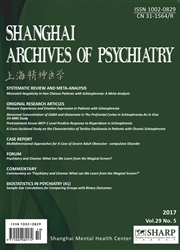

 中文摘要:
中文摘要:
背景:儿童期精神分裂是一种严重的精神障碍,有理论认为其认知功能无论是意识水平还是潜意识水平都存在异常.但目前尚无针对儿童期精神分裂的潜意识认知功能研究.目的:开发新的双眼竞争测验版本,用于评估个体在意识和潜意识状态下对人际交往信息的认知加工过程,并依此判断儿童期精神分裂症患者的社会认知功能是否受损.方法:选取3种不同类型的图片(图片中无人物、有2~3个人物、有4个及以上的人物)共30张,这些图片在双眼竞争测验不可见模式(存在双眼竞争性抑制,反映潜意识状态下认知加工)和可见模式(无双眼竞争性抑制,反映意识状态下)中展示.对15名年龄≤16岁、以妄想为主要症状的精神分裂症患者及15名健康儿童进行双眼竞争测验,通过对目标图片出现后立即在其左侧或右侧出现光栅的方向的判别来比较两组儿童的正确率,并比较两组间的反应时间.结果:患者组对所有类型图片中光栅方向判断的正确率均低于对照组,但是12对比较中仅2对的差异有统计学意义.与对照组相比,无论是在可见模式还是非可见模式下,患者对人物图片的注意要比对无人图片的注意有所增加,但无显著性意义.我们并未发现精神病性症状的严重程度与对图像认知加工的受损程度之间存在任何关联.当要求被试对三组图片进行评分时,患者组对存在2~3个人物的图片报告的高兴程度明显高于对照组的评分,差异有统计学意义.结论:儿童期精神分裂症患者对描绘人际关系的图片注意一定程度的增加,提示该病与社会信息的认知处理过程受损相关,但目前结果尚不能证实这一关系.我们将双眼竞争范式应用于认知功能差异的研究,只是取得部分的成功,其主要原因是该测验中对不同类型图片的反应注意量的关键指标存在较大的变异.
 英文摘要:
英文摘要:
Background: Childhood schizophrenia is a severe mental disorder that is believed to affect both conscious and unconscious cognitive functioning, but there have been few studies that have assessed this. Objective: Develop a version of the binocular rivalry test that will assess the conscious and unconscious cognitive processing of interpersonal information and use this test to determine whether or not social cognition is impaired in children with schizophrenia. Methods: Thirty images of three types -with no persons, with 2-3 persons and with 4+ persons -were selected for use in a binocular rivalry test that presented the images both in an interocularly suppressed (unconscious) format and an unsuppressed (conscious) format. Fifteen children under 16 years of age with schizophrenia who had prominent delusional symptoms and 15 healthy children were administered the test. Accuracy rates (in assessing the left or right orientation of a patch presented immediately after the target images) and reaction times were compared between patients and controls. Results: For all types of pictures, the accuracy of patients was less than that of controls, though the differences were only significant in two of the twelve comparisons assessed. Compared to controls, patients showed a non- significant increase in the attention paid to images with people in them compared to images without people in them, both for conscious and unconscious presentations of the images. We did not find any relationship between the severity of psychotic symptoms in the patients and the degree of impairment in the cognitive processing of images. When asked to assess the attributes of the images, patients reported significantly higher levels of happiness depicted in images with 2-3 people than controls. Conclusions: The non-significant increase in the attention children with schizophrenia paid to images depicting interpersonal relationships suggests, but does not prove, that the illness is associated with impairments in the cognitive pr
 同期刊论文项目
同期刊论文项目
 同项目期刊论文
同项目期刊论文
 Abnormalities of White Matter Microstructure in Unmedicated Obsessive-Compulsive Disorder and Change
Abnormalities of White Matter Microstructure in Unmedicated Obsessive-Compulsive Disorder and Change Both Physical Activity and Food Intake are Associated with Metabolic Risks in Patients with Schizoph
Both Physical Activity and Food Intake are Associated with Metabolic Risks in Patients with Schizoph Should Repetitive Transcranial Magnetic Stimulation (rTMS) be Considered an Affective Adjunctive Tre
Should Repetitive Transcranial Magnetic Stimulation (rTMS) be Considered an Affective Adjunctive Tre 期刊信息
期刊信息
